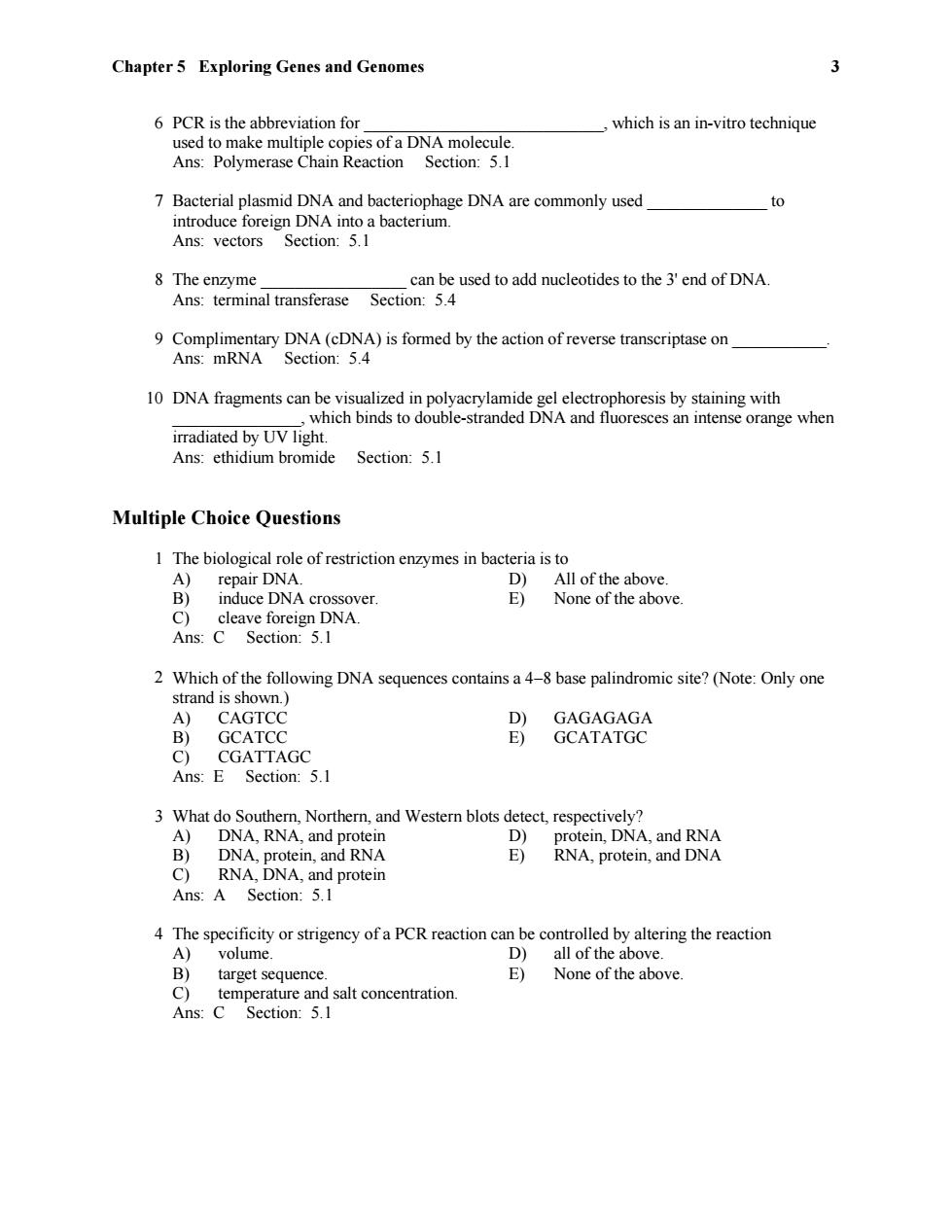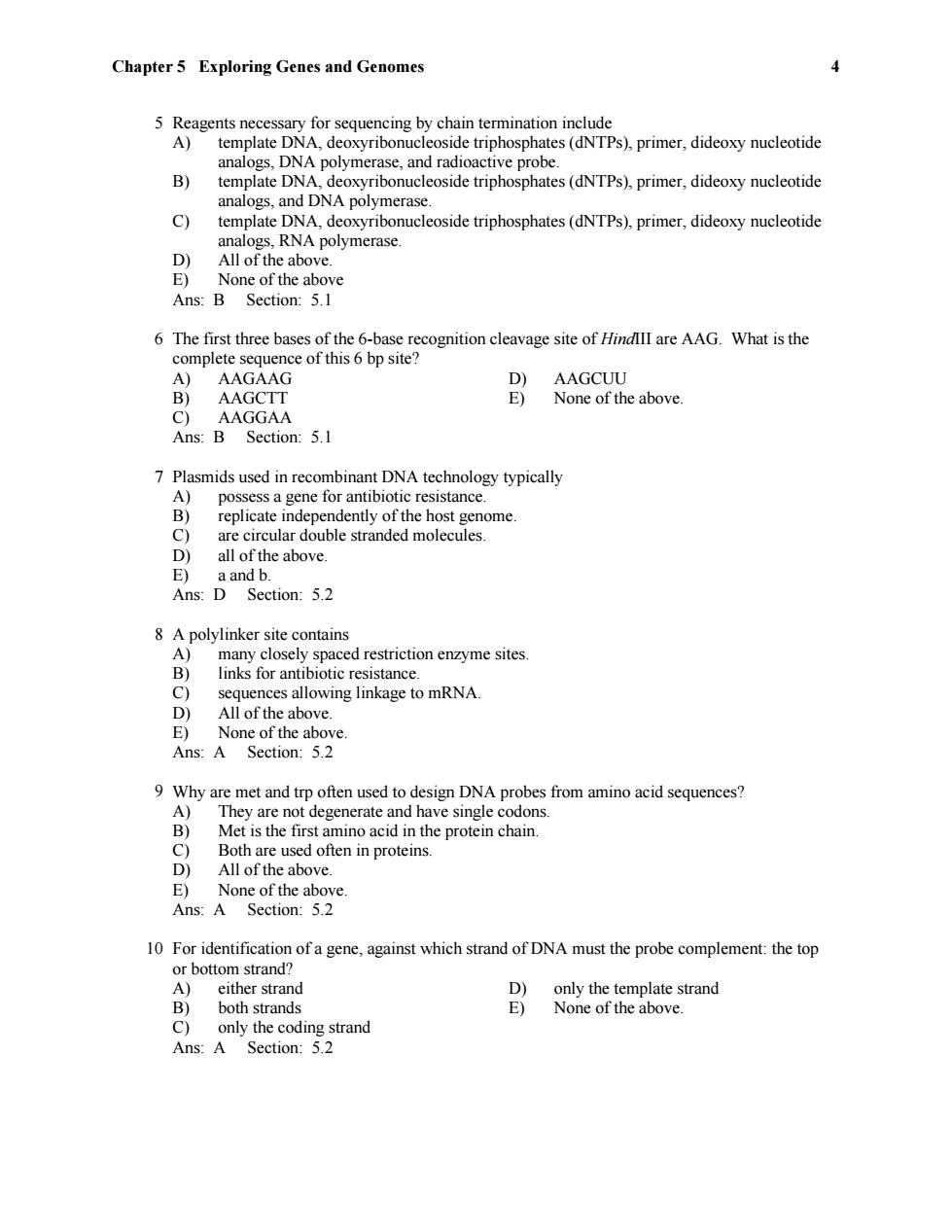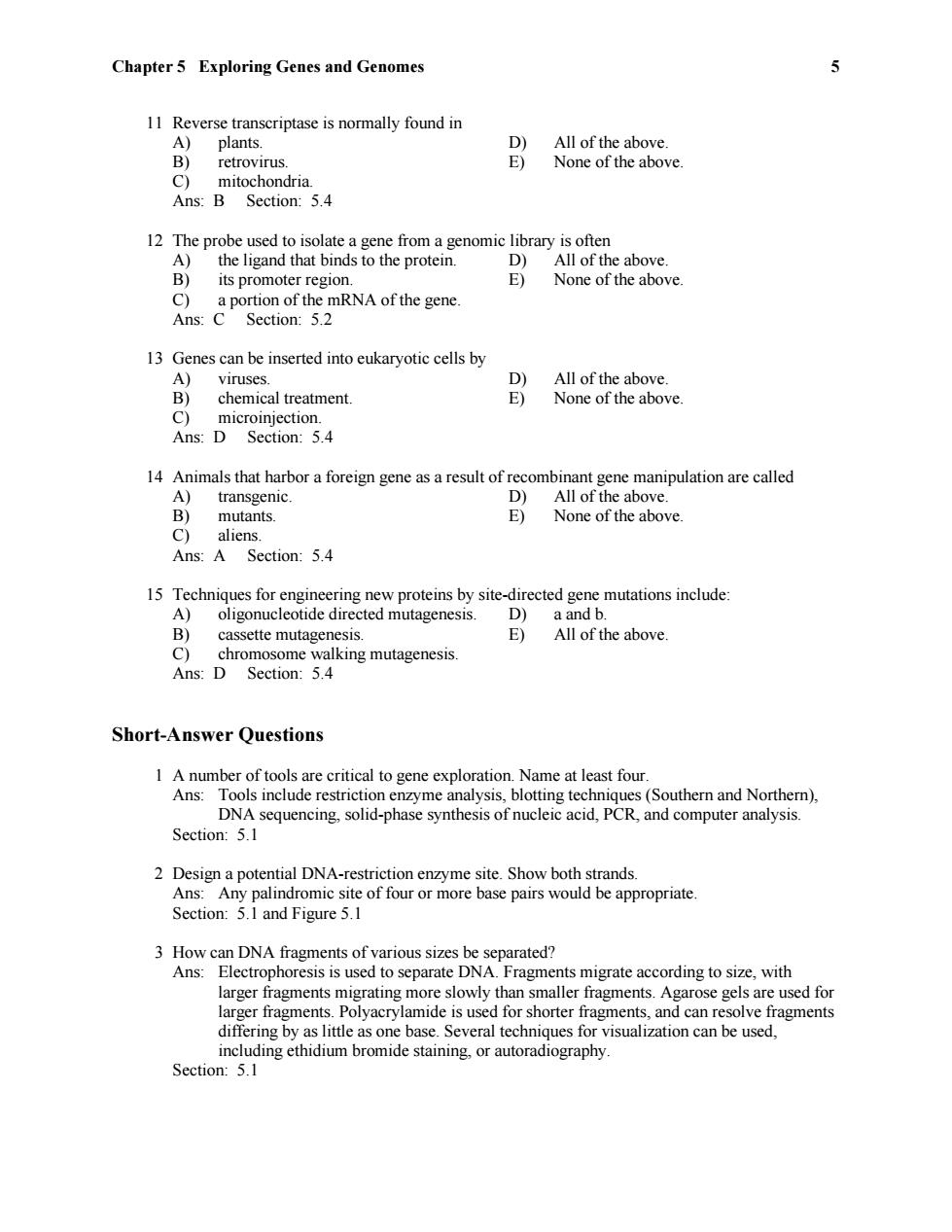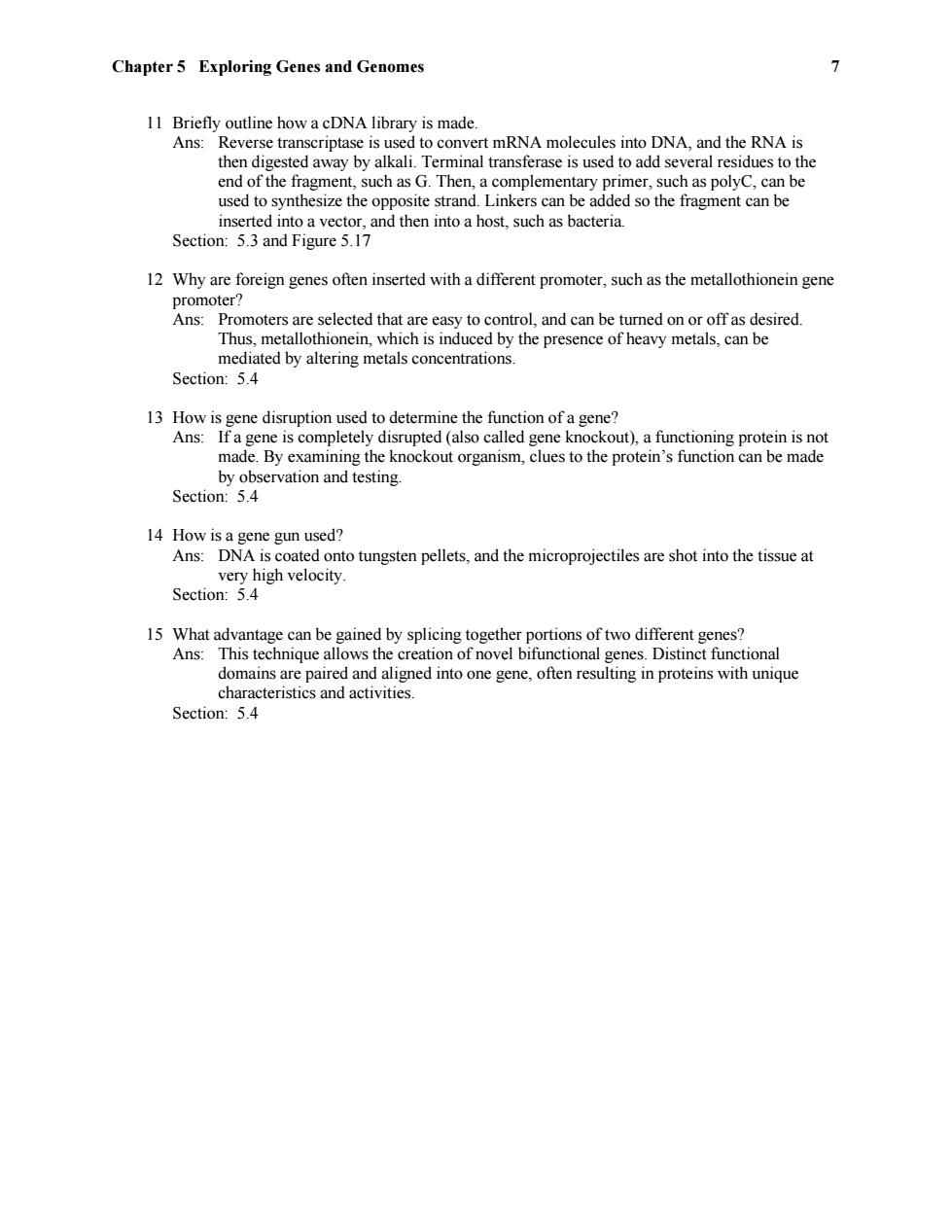
Chapter 5 Exploring Genes and Genomes Matching Questions Use the following to answer questions 1-10: Choose the correct answer from the list below.Not all of the answers will be used. a)Haemophilus influenzae b)restriction enzymes c)pUC18 d)expression e)Sanger f)footprint g)vector h)E.coli i)fingerprint j)reverse trancriptase k)fluorescent 1)Kary Mullis 1 Arber,Smith,and Nathans discovered and pioneered the use of Ans:b Section:5.1 2 A pattern of DNA fragments can serve as a of a particular DNA molecule. Ans:i Section:5.1 3 The most common type of DNA sequencing is Ans:e Section:5.1 4 Instead of radioactivity,current DNA sequencing commonly uses base analogues. Ans:k Section:5.1 5 The first genome to be sequenced of a free-living organism. Ans:a Section:5.3
Chapter 5 Exploring Genes and Genomes Matching Questions Use the following to answer questions 1-10: Choose the correct answer from the list below. Not all of the answers will be used. a) Haemophilus influenzae b) restriction enzymes c) pUC18 d) expression e) Sanger f) footprint g) vector h) E. coli i) fingerprint j) reverse trancriptase k) fluorescent l) Kary Mullis 1 Arber, Smith, and Nathans discovered and pioneered the use of ____________. Ans: b Section: 5.1 2 A pattern of DNA fragments can serve as a ____________ of a particular DNA molecule. Ans: i Section: 5.1 3 The most common type of DNA sequencing is ____________. Ans: e Section: 5.1 4 Instead of radioactivity, current DNA sequencing commonly uses ____________ base analogues. Ans: k Section: 5.1 5 ____________ The first genome to be sequenced of a free-living organism. Ans: a Section: 5.3

Chapter 5 Exploring Genes and Genomes 2 6 Won the Nobel prize for discovery of the polymerase chain reaction. Ans:I Section:5.1 7 A plasmid is an example of a common Ans:g Section:5.2 P A plasmid vector that contains the B-galactosidase gene and is useful for screening cells with recombined DNA. Ans:c Section:5.2 9 The enzyme used to create DNA from RNA Ans:j Section:5.4 10 The type of vector used for synthesis of protein. Ans:d Section:5.4 Fill in the Blank Questions 1 The enzyme that catalyzes the formation of a phosphodiester linkage at a break in a DNA strand is Ans:DNA ligase Section:5.1 cleave DNA at sites with inverted repeat sequences referred to as palendromic sequences. Ans:Restriction endonucleases Section:5.1 3 Complementary,single-strand overhangs that are produced by some restriction endonucleases are referred to as Ans:sticky ends or cohesive ends Section:5.2 4 The Sanger technique for sequencing DNA involves the use of nucleotide analogs that terminate chain elongation. Ans:2,3'-dideoxy Section:5.1 5 In solid-phase synthesis of oligonucleotides,the 2'deoxyribonucleotide-3'-phosphoramidite is added to the end of the growing oligonucleotide. Ans:5'Section:5.1
Chapter 5 Exploring Genes and Genomes 2 6 ____________ Won the Nobel prize for discovery of the polymerase chain reaction. Ans: l Section: 5.1 7 A plasmid is an example of a common ____________. Ans: g Section: 5.2 8 ____________ A plasmid vector that contains the β-galactosidase gene and is useful for screening cells with recombined DNA. Ans: c Section: 5.2 9 ____________ The enzyme used to create DNA from RNA. Ans: j Section: 5.4 10 ____________ The type of vector used for synthesis of protein. Ans: d Section: 5.4 Fill in the Blank Questions 1 The enzyme that catalyzes the formation of a phosphodiester linkage at a break in a DNA strand is __________________. Ans: DNA ligase Section: 5.1 2 ___________________________ cleave DNA at sites with inverted repeat sequences referred to as palendromic sequences. Ans: Restriction endonucleases Section: 5.1 3 Complementary, single-strand overhangs that are produced by some restriction endonucleases are referred to as ___________________. Ans: sticky ends or cohesive ends Section: 5.2 4 The Sanger technique for sequencing DNA involves the use of __________________ nucleotide analogs that terminate chain elongation. Ans: 2',3'-dideoxy Section: 5.1 5 In solid-phase synthesis of oligonucleotides, the 2'deoxyribonucleotide-3'-phosphoramidite is added to the _______ end of the growing oligonucleotide. Ans: 5' Section: 5.1

Chapter 5 Exploring Genes and Genomes 3 6 PCR is the abbreviation for which is an in-vitro technique used to make multiple copies of a DNA molecule. Ans:Polymerase Chain Reaction Section:5.1 7 Bacterial plasmid DNA and bacteriophage DNA are commonly used to introduce foreign DNA into a bacterium. Ans:vectors Section:5.1 8 The enzyme can be used to add nucleotides to the 3'end of DNA Ans:terminal transferase Section:5.4 9 Complimentary DNA(cDNA)is formed by the action of reverse transcriptase on Ans:mRNA Section:5.4 10 DNA fragments can be visualized in polyacrylamide gel electrophoresis by staining with which binds to double-stranded DNA and fluoresces an intense orange when irradiated by UV light. Ans:ethidium bromide Section:5.1 Multiple Choice Questions 1 The biological role of restriction enzymes in bacteria is to A)repair DNA. D) All of the above. B) induce DNA crossover. E) None of the above. C) cleave foreign DNA. Ans:C Section:5.1 2 Which of the following DNA sequences contains a 4-8 base palindromic site?(Note:Only one strand is shown. A) CAGTCC D GAGAGAGA B) GCATCC E) GCATATGC C) CGATTAGC Ans:E Section:5.1 3 What do Southern,Northern,and Western blots detect,respectively? A) DNA,RNA,and protein D) protein,DNA,and RNA B) DNA,protein,and RNA E) RNA,protein,and DNA C)RNA,DNA,and protein Ans:A Section:5.1 4 The specificity or strigency of a PCR reaction can be controlled by altering the reaction A)volume. D)all of the above. B)target sequence. E) None of the above. C)temperature and salt concentration. Ans:C Section:5.1
Chapter 5 Exploring Genes and Genomes 3 6 PCR is the abbreviation for ____________________________, which is an in-vitro technique used to make multiple copies of a DNA molecule. Ans: Polymerase Chain Reaction Section: 5.1 7 Bacterial plasmid DNA and bacteriophage DNA are commonly used ______________ to introduce foreign DNA into a bacterium. Ans: vectors Section: 5.1 8 The enzyme _________________ can be used to add nucleotides to the 3' end of DNA. Ans: terminal transferase Section: 5.4 9 Complimentary DNA (cDNA) is formed by the action of reverse transcriptase on ___________. Ans: mRNA Section: 5.4 10 DNA fragments can be visualized in polyacrylamide gel electrophoresis by staining with _______________, which binds to double-stranded DNA and fluoresces an intense orange when irradiated by UV light. Ans: ethidium bromide Section: 5.1 Multiple Choice Questions 1 The biological role of restriction enzymes in bacteria is to A) repair DNA. D) All of the above. B) induce DNA crossover. E) None of the above. C) cleave foreign DNA. Ans: C Section: 5.1 2 Which of the following DNA sequences contains a 48 base palindromic site? (Note: Only one strand is shown.) A) CAGTCC D) GAGAGAGA B) GCATCC E) GCATATGC C) CGATTAGC Ans: E Section: 5.1 3 What do Southern, Northern, and Western blots detect, respectively? A) DNA, RNA, and protein D) protein, DNA, and RNA B) DNA, protein, and RNA E) RNA, protein, and DNA C) RNA, DNA, and protein Ans: A Section: 5.1 4 The specificity or strigency of a PCR reaction can be controlled by altering the reaction A) volume. D) all of the above. B) target sequence. E) None of the above. C) temperature and salt concentration. Ans: C Section: 5.1

Chapter 5 Exploring Genes and Genomes 4 5 Reagents necessary for sequencing by chain termination include A)template DNA,deoxyribonucleoside triphosphates(dNTPs),primer,dideoxy nucleotide analogs,DNA polymerase,and radioactive probe. B) template DNA,deoxyribonucleoside triphosphates(dNTPs),primer,dideoxy nucleotide analogs,and DNA polymerase. C) template DNA,deoxyribonucleoside triphosphates(dNTPs),primer,dideoxy nucleotide analogs,RNA polymerase. D) All of the above. E) None of the above Ans:B Section:5.1 6 The first three bases of the 6-base recognition cleavage site of HindllI are AAG.What is the complete sequence of this 6 bp site? A)AAGAAG D) AAGCUU B)AAGCTT E) None of the above C)AAGGAA Ans:B Section:5.1 7 Plasmids used in recombinant DNA technology typically A) possess a gene for antibiotic resistance. B) replicate independently of the host genome. C) are circular double stranded molecules. D) all of the above E)a and b. Ans:D Section:5.2 8 A polylinker site contains A) many closely spaced restriction enzyme sites. B) links for antibiotic resistance. C) sequences allowing linkage to mRNA. D) All of the above. E) None of the above. Ans:A Section:5.2 9 Why are met and trp often used to design DNA probes from amino acid sequences? A)They are not degenerate and have single codons. B) Met is the first amino acid in the protein chain. C) Both are used often in proteins. D) All of the above. E) None of the above. Ans:A Section:5.2 10 For identification of a gene,against which strand of DNA must the probe complement:the top or bottom strand? A)either strand D only the template strand B)both strands E) None of the above. C)only the coding strand Ans:A Section:5.2
Chapter 5 Exploring Genes and Genomes 4 5 Reagents necessary for sequencing by chain termination include A) template DNA, deoxyribonucleoside triphosphates (dNTPs), primer, dideoxy nucleotide analogs, DNA polymerase, and radioactive probe. B) template DNA, deoxyribonucleoside triphosphates (dNTPs), primer, dideoxy nucleotide analogs, and DNA polymerase. C) template DNA, deoxyribonucleoside triphosphates (dNTPs), primer, dideoxy nucleotide analogs, RNA polymerase. D) All of the above. E) None of the above Ans: B Section: 5.1 6 The first three bases of the 6-base recognition cleavage site of HindIII are AAG. What is the complete sequence of this 6 bp site? A) AAGAAG D) AAGCUU B) AAGCTT E) None of the above. C) AAGGAA Ans: B Section: 5.1 7 Plasmids used in recombinant DNA technology typically A) possess a gene for antibiotic resistance. B) replicate independently of the host genome. C) are circular double stranded molecules. D) all of the above. E) a and b. Ans: D Section: 5.2 8 A polylinker site contains A) many closely spaced restriction enzyme sites. B) links for antibiotic resistance. C) sequences allowing linkage to mRNA. D) All of the above. E) None of the above. Ans: A Section: 5.2 9 Why are met and trp often used to design DNA probes from amino acid sequences? A) They are not degenerate and have single codons. B) Met is the first amino acid in the protein chain. C) Both are used often in proteins. D) All of the above. E) None of the above. Ans: A Section: 5.2 10 For identification of a gene, against which strand of DNA must the probe complement: the top or bottom strand? A) either strand D) only the template strand B) both strands E) None of the above. C) only the coding strand Ans: A Section: 5.2

Chapter 5 Exploring Genes and Genomes 11 Reverse transcriptase is normally found in A) plants. D) All of the above. B) retrovirus. E) None of the above. c) mitochondria. Ans:B Section:5.4 12 The probe used to isolate a gene from a genomic library is often A)the ligand that binds to the protein. D) All of the above. B) its promoter region. E) None of the above. C)a portion of the mRNA of the gene. Ans:C Section:5.2 13 Genes can be inserted into eukaryotic cells by A)viruses. D) All of the above. B) chemical treatment. E) None of the above. C) microinjection. Ans:D Section:5.4 14 Animals that harbor a foreign gene as a result of recombinant gene manipulation are called A) transgenic. D) All of the above. B) mutants E) None of the above. C)aliens Ans:A Section:5.4 15 Techniques for engineering new proteins by site-directed gene mutations include: A) oligonucleotide directed mutagenesis.D) a and b. B) cassette mutagenesis. E)All of the above. C) chromosome walking mutagenesis. Ans:D Section:5.4 Short-Answer Questions 1 A number of tools are critical to gene exploration.Name at least four. Ans:Tools include restriction enzyme analysis,blotting techniques(Southern and Northern), DNA sequencing,solid-phase synthesis of nucleic acid,PCR,and computer analysis. Section:5.1 2 Design a potential DNA-restriction enzyme site.Show both strands. Ans:Any palindromic site of four or more base pairs would be appropriate. Section:5.1 and Figure 5.1 3 How can DNA fragments of various sizes be separated? Ans:Electrophoresis is used to separate DNA.Fragments migrate according to size,with larger fragments migrating more slowly than smaller fragments.Agarose gels are used for larger fragments.Polyacrylamide is used for shorter fragments,and can resolve fragments differing by as little as one base.Several techniques for visualization can be used, including ethidium bromide staining,or autoradiography. Section:5.1
Chapter 5 Exploring Genes and Genomes 5 11 Reverse transcriptase is normally found in A) plants. D) All of the above. B) retrovirus. E) None of the above. C) mitochondria. Ans: B Section: 5.4 12 The probe used to isolate a gene from a genomic library is often A) the ligand that binds to the protein. D) All of the above. B) its promoter region. E) None of the above. C) a portion of the mRNA of the gene. Ans: C Section: 5.2 13 Genes can be inserted into eukaryotic cells by A) viruses. D) All of the above. B) chemical treatment. E) None of the above. C) microinjection. Ans: D Section: 5.4 14 Animals that harbor a foreign gene as a result of recombinant gene manipulation are called A) transgenic. D) All of the above. B) mutants. E) None of the above. C) aliens. Ans: A Section: 5.4 15 Techniques for engineering new proteins by site-directed gene mutations include: A) oligonucleotide directed mutagenesis. D) a and b. B) cassette mutagenesis. E) All of the above. C) chromosome walking mutagenesis. Ans: D Section: 5.4 Short-Answer Questions 1 A number of tools are critical to gene exploration. Name at least four. Ans: Tools include restriction enzyme analysis, blotting techniques (Southern and Northern), DNA sequencing, solid-phase synthesis of nucleic acid, PCR, and computer analysis. Section: 5.1 2 Design a potential DNA-restriction enzyme site. Show both strands. Ans: Any palindromic site of four or more base pairs would be appropriate. Section: 5.1 and Figure 5.1 3 How can DNA fragments of various sizes be separated? Ans: Electrophoresis is used to separate DNA. Fragments migrate according to size, with larger fragments migrating more slowly than smaller fragments. Agarose gels are used for larger fragments. Polyacrylamide is used for shorter fragments, and can resolve fragments differing by as little as one base. Several techniques for visualization can be used, including ethidium bromide staining, or autoradiography. Section: 5.1

Chapter 5 Exploring Genes and Genomes 6 4 What is a DNA probe? Ans:A DNA probe is used to identify specific DNA fragments.The probe sequence is complementary to the DNA sequence of interest,thus it can base pair,or hybridize,with the DNA strand.Probes can be small oligomers or long fragments.They are labeled for detection using radioactivity or another tag,such as fluorescent probes. Section:5.1 5 What is the basis of the Sanger method? Ans:Sanger sequencing is based upon replication of DNA under conditions in which the chain is terminated by controlled interruption,resulting in various sizes of DNA fragments.By including limited amounts of radioactive bases,strands differing by one base in length can be observed.By reading the bands,the sequence can be determined.(Fluorescent or dye tags can also be used in an automated process. Section:5.1 6 Explain the basis of the polymerase chain reaction. Ans:Using primers that flank the sequence of interest and carrying out repetitive replication reactions can make copies of a particular DNA fragment.Template DNA,DNA polymerase,dNTPs,and other necessary reagents are added to the reaction mixture.The DNA is heated to separate the strands,cooled to allow the primers to anneal,and then replicated.The process is repeated many times,each time doubling the number of DNA copies present.The enzyme used is thermostable,and can withstand the repetitive heating and cooling steps. Section:5.1 and Figure 5.8 7 Describe two ways PCR can be used in medical diagnosis. Ans:PCR can be used to identify the presence of infecting bacteria or viruses;can detect if certain mutations,such as those found in cancer cells,are present;and can be used as a diagnostic tool to investigate known gene mutations. Section:5.1 8 Briefly outline the steps necessary to create a recombinant DNA molecule. Ans:Both the fragment of interest and the vector DNA are cut with restriction enzyme(s), which create complementary sticky ends.The pieces of DNA are allowed to anneal and DNA ligase is added to join the ends. Section:5.2 9 How is a single gene of interest identified on a plate containing many different library clones? Ans:By using a probe specific for the DNA of interest,the clone can be identified.The probe is designed to hybridize to the DNA of the clone that has been transferred to the membrane.The probe is labeled with radioactivity or another tag so that it can be easily detected and the proper clone identified and selected. Section:5.2 10 If a gene is inserted into an antibiotic marker gene in a plasmid such as ampicilin,will the resulting clone be sensitive or resistant to the antibiotic? Ans:When inserted into a gene,the new DNA interrupts the previous gene.Thus,the antibiotic gene is unlikely to be functional,the clone will be sensitive to the antibiotic, and the clone will not grow. Section:5.2
Chapter 5 Exploring Genes and Genomes 6 4 What is a DNA probe? Ans: A DNA probe is used to identify specific DNA fragments. The probe sequence is complementary to the DNA sequence of interest, thus it can base pair, or hybridize, with the DNA strand. Probes can be small oligomers or long fragments. They are labeled for detection using radioactivity or another tag, such as fluorescent probes. Section: 5.1 5 What is the basis of the Sanger method? Ans: Sanger sequencing is based upon replication of DNA under conditions in which the chain is terminated by controlled interruption, resulting in various sizes of DNA fragments. By including limited amounts of radioactive bases, strands differing by one base in length can be observed. By reading the bands, the sequence can be determined. (Fluorescent or dye tags can also be used in an automated process.) Section: 5.1 6 Explain the basis of the polymerase chain reaction. Ans: Using primers that flank the sequence of interest and carrying out repetitive replication reactions can make copies of a particular DNA fragment. Template DNA, DNA polymerase, dNTPs, and other necessary reagents are added to the reaction mixture. The DNA is heated to separate the strands, cooled to allow the primers to anneal, and then replicated. The process is repeated many times, each time doubling the number of DNA copies present. The enzyme used is thermostable, and can withstand the repetitive heating and cooling steps. Section: 5.1 and Figure 5.8 7 Describe two ways PCR can be used in medical diagnosis. Ans: PCR can be used to identify the presence of infecting bacteria or viruses; can detect if certain mutations, such as those found in cancer cells, are present; and can be used as a diagnostic tool to investigate known gene mutations. Section: 5.1 8 Briefly outline the steps necessary to create a recombinant DNA molecule. Ans: Both the fragment of interest and the vector DNA are cut with restriction enzyme(s), which create complementary sticky ends. The pieces of DNA are allowed to anneal and DNA ligase is added to join the ends. Section: 5.2 9 How is a single gene of interest identified on a plate containing many different library clones? Ans: By using a probe specific for the DNA of interest, the clone can be identified. The probe is designed to hybridize to the DNA of the clone that has been transferred to the membrane. The probe is labeled with radioactivity or another tag so that it can be easily detected and the proper clone identified and selected. Section: 5.2 10 If a gene is inserted into an antibiotic marker gene in a plasmid such as ampicilin, will the resulting clone be sensitive or resistant to the antibiotic? Ans: When inserted into a gene, the new DNA interrupts the previous gene. Thus, the antibiotic gene is unlikely to be functional, the clone will be sensitive to the antibiotic, and the clone will not grow. Section: 5.2

Chapter 5 Exploring Genes and Genomes 7 11 Briefly outline how a cDNA library is made. Ans:Reverse transcriptase is used to convert mRNA molecules into DNA,and the RNA is then digested away by alkali.Terminal transferase is used to add several residues to the end of the fragment,such as G.Then,a complementary primer,such as polyC,can be used to synthesize the opposite strand.Linkers can be added so the fragment can be inserted into a vector.and then into a host.such as bacteria. Section:5.3 and Figure 5.17 12 Why are foreign genes often inserted with a different promoter,such as the metallothionein gene promoter? Ans:Promoters are selected that are easy to control,and can be turned on or off as desired. Thus,metallothionein,which is induced by the presence of heavy metals,can be mediated by altering metals concentrations. Section:5.4 13 How is gene disruption used to determine the function of a gene? Ans:If a gene is completely disrupted (also called gene knockout),a functioning protein is not made.By examining the knockout organism,clues to the protein's function can be made by observation and testing. Section:5.4 14 How is a gene gun used? Ans:DNA is coated onto tungsten pellets,and the microprojectiles are shot into the tissue at very high velocity. Section:5.4 15 What advantage can be gained by splicing together portions of two different genes? Ans:This technique allows the creation of novel bifunctional genes.Distinct functional domains are paired and aligned into one gene,often resulting in proteins with unique characteristics and activities. Section:5.4
Chapter 5 Exploring Genes and Genomes 7 11 Briefly outline how a cDNA library is made. Ans: Reverse transcriptase is used to convert mRNA molecules into DNA, and the RNA is then digested away by alkali. Terminal transferase is used to add several residues to the end of the fragment, such as G. Then, a complementary primer, such as polyC, can be used to synthesize the opposite strand. Linkers can be added so the fragment can be inserted into a vector, and then into a host, such as bacteria. Section: 5.3 and Figure 5.17 12 Why are foreign genes often inserted with a different promoter, such as the metallothionein gene promoter? Ans: Promoters are selected that are easy to control, and can be turned on or off as desired. Thus, metallothionein, which is induced by the presence of heavy metals, can be mediated by altering metals concentrations. Section: 5.4 13 How is gene disruption used to determine the function of a gene? Ans: If a gene is completely disrupted (also called gene knockout), a functioning protein is not made. By examining the knockout organism, clues to the protein’s function can be made by observation and testing. Section: 5.4 14 How is a gene gun used? Ans: DNA is coated onto tungsten pellets, and the microprojectiles are shot into the tissue at very high velocity. Section: 5.4 15 What advantage can be gained by splicing together portions of two different genes? Ans: This technique allows the creation of novel bifunctional genes. Distinct functional domains are paired and aligned into one gene, often resulting in proteins with unique characteristics and activities. Section: 5.4